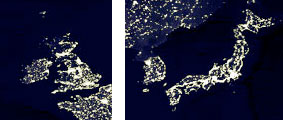
Tokyoites, like residents of many big cities, are used to bright nights. In the wake of the failure of the Fukushima nuclear plant and power station, Tokyo is trying to save electricity. For example, in subway tunnels, only one of every three ceiling lights is being lit, and the huge, bustling Shinjuku area of downtown Tokyo has many signs left dark. But despite these cuts, one news station shows that even at current levels, Tokyo is just as bright as London. In general, Tokyoites are used to much brighter (and more) lights than Londoners.
Above, you can see a NASA map of Japan and London from space at night. Despite having comparable populations of around 12 million, London and Tokyo look different from space. Tokyo looks brighter, though that could be because of Japan’s overall higher population density. The people in Tokyo interviewed in the video say that they’re okay with things being a little darker than before, and Londoners seem fine with their slightly darker city. So perhaps going forward, Japan could consider reducing its non-essential electricity use. This could be particularly true in the case of hot, humid, Tokyo summers, when overall energy use increases as residents turn to air conditioning and fans to cool down. Some Tokyoites, stuck after the earthquake disrupted train service, have already switched to non-electric forms of transportation like bicycles that would remain unaffected by rolling blackouts.
As a side note, I remain encouraged that the situation in Japan will improve and later this year (with any luck) Tokyoites will have a life that more closely resembles normal. If anything, at least when a Japanese company like Tepco suffers a huge disaster, they cut executive pay rather than give them bonuses for “the best year in safety performance in our company’s history” like Transocean did after the BP spill.
h/t JapanProbe












